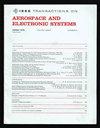Formation Control for Enclosing and Tracking via Relative Localization
IF 5.7
2区 计算机科学
Q1 ENGINEERING, AEROSPACE
IEEE Transactions on Aerospace and Electronic Systems
Pub Date : 2025-04-18
DOI:10.1109/TAES.2025.3557798
引用次数: 0
Abstract
This article proposes an integrated framework for coordinating multiple unmanned aerial vehicles (UAVs) in a distributed manner to persistently enclose and track a moving target without relying on external localization systems. The proposed framework consists of three modules: cooperative state estimators, circular formation pattern generators, and formation tracking controllers. In the cooperative state estimation module, a recursive least-squares estimator for estimating the relative positions between UAVs is integrated with a distributed Kalman filter, enabling a persistent estimation of the target's state. When a UAV loses direct measurements of the target due to environmental occlusion, measurements from neighbors are aligned into the UAV's local frame to provide indirect measurements. The second module focuses on planning a desired circular formation pattern using a coupled oscillator model. This pattern ensures an even distribution of UAVs around a circle that encloses the moving target. The persistent excitation property of the circular formation is crucial for achieving convergence in the first module. Finally, a consensus-based formation controller is designed to enable multiple UAVs to asymptotically track the planned circular formation pattern while ensuring bounded control inputs. Theoretical analysis demonstrates that the proposed framework ensures asymptotic tracking of a target with constant velocity. For a target with varying velocity, the tracking error converges to a bounded region related to the target's maximum acceleration. Simulations and experiments validate the effectiveness of the proposed algorithm.通过相对定位实现包围和跟踪的编队控制
本文提出了一种集成框架,用于协调多架无人机以分布式方式持续包围和跟踪运动目标,而不依赖外部定位系统。该框架由三个模块组成:协作状态估计器、圆形编队模式生成器和编队跟踪控制器。在协同状态估计模块中,将用于估计无人机间相对位置的递归最小二乘估计器与分布式卡尔曼滤波器相结合,实现对目标状态的持续估计。当无人机由于环境遮挡而失去对目标的直接测量时,来自邻居的测量将对齐到无人机的本地帧中以提供间接测量。第二个模块的重点是规划一个理想的圆形形成模式使用耦合振荡器模型。这种模式确保了无人机在一个包围移动目标的圆圈周围均匀分布。圆形结构的持续激发特性对于实现第一个模块的收敛是至关重要的。最后,设计了基于共识的编队控制器,使多架无人机能够在保证有界控制输入的同时,渐进地跟踪规划的圆形编队模式。理论分析表明,所提出的框架能够保证恒速度目标的渐近跟踪。对于速度变化的目标,跟踪误差收敛到目标最大加速度相关的有界区域。仿真和实验验证了该算法的有效性。
本文章由计算机程序翻译,如有差异,请以英文原文为准。
求助全文
约1分钟内获得全文
求助全文
来源期刊
CiteScore
7.80
自引率
13.60%
发文量
433
审稿时长
8.7 months
期刊介绍:
IEEE Transactions on Aerospace and Electronic Systems focuses on the organization, design, development, integration, and operation of complex systems for space, air, ocean, or ground environment. These systems include, but are not limited to, navigation, avionics, spacecraft, aerospace power, radar, sonar, telemetry, defense, transportation, automated testing, and command and control.

 求助内容:
求助内容: 应助结果提醒方式:
应助结果提醒方式:


